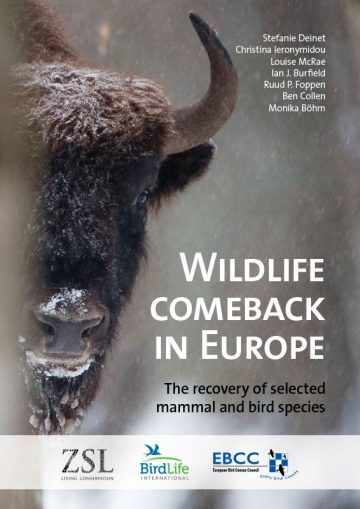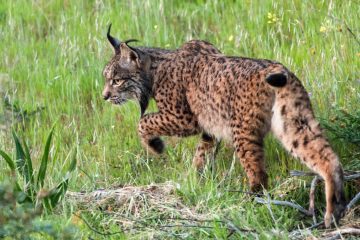Rewilding Europe has commissioned a science-based overview of changes in the abundance and distribution of selected wildlife species in Europe. The updated Wildlife Comeback report will provide the latest and state-of-the-art insights, opportunities and challenges for wildlife comeback at a European scale.

Reasons for optimism
One of the core objectives of rewilding is to support wildlife comeback, either by creating the conditions for wildlife to return of its own accord, or by restocking or reintroducing animals into habitats where they are missing. A long-term decline in European biodiversity makes the urgent prioritisation of supporting wildlife comeback at both European and national levels all the more critical.
Despite this overall decline, however, many wildlife species have made a spectacular return across Europe over the last four decades, proving that wild nature is resilient and can recover if conditions are suitable. Factors such as increased legal protection, reintroductions, and other population support measures, corridor creation, and an ever greater willingness and desire by Europeans to live alongside and enjoy the presence of wild animals have all contributed to this recovery.
Updated report

To learn more about wildlife comeback in Europe, and to better support it going forwards, Rewilding Europe has commissioned the Zoological Society of London (ZSL), BirdLife International and the European Bird Census Council to produce a Wildlife Comeback Report. Scientists from all three independent institutions will work on the study – a state-of-the-art, science-based, peer-reviewed overview of the comeback of a range of European wildlife species. Presenting changes in numbers and distribution, it will enable a better understanding of why some European animals are faring better than others.
The production of this new report, which is scheduled for publication in September 2022, is funded by Arcadia – a charitable fund of Lisbet Rausing and Peter Baldwin -, WWF Netherlands, and the Dutch Postcode Lottery. It represents an update of a report produced by the same three partners in 2013, which profiled mammals such as the European bison and grey wolf, as well as birds such as the griffon vulture and white-tailed eagle. This time round more emphasis will be placed on understanding the underlying mechanisms for the comeback of each animal, while associated academic papers will also be published.
Enhanced and timely analysis

The updated report will include some new bird and mammal species. “In conservation, it is quite normal to describe the threats and reasons for species’ declines and make red lists’’, says Frans Schepers, Managing Director of Rewilding Europe. “But what if we can learn from success stories, and find out how we can accelerate wildlife recovery using those lessons? This is one of the main reasons why we have commissioned this study’’, he explains.
Around 50 species in total will be covered, with the final selection of new species depending on the amount of data available. New mammals will probably include the Eurasian otter, humpback whale, ringed seal, and several species of bats.
Some of the information contained in the first wildlife comeback report dated back to 2005, which means the new instalment may include up to 10 years of new data for many species. A number of species, such as the Iberian lynx, grey wolf, common crane, peregrine falcon and white-tailed eagle, have extended their range and increased in population size over this timeframe.
“Adding more recent information for the species previously included, as well as information on new species, will not only give a more up-to-date picture of the species that are recovering in number and range but also provide a broader overview of which factors may have contributed to their return,” explains Stefanie Deinet, lead author of the previous Wildlife Comeback Report. “It will be interesting to see whether distributions have changed, and to perhaps see common areas of expansion, such as into western Europe, for example.”
Living alongside wildlife

The fact that many wildlife species are making a comeback in Europe means that a growing number of people are now living in close proximity to them – whether that be wolves in the Netherlands, Eurasian lynx in Slovenia, or European bison in the Southern Carpathians of Romania.
This means Europeans now have an unprecedented opportunity to reconnect with these species, and to learn more about the amazing wildlife that exists right on their doorstep. It also means that efforts to promote harmonious relations between people and wildlife, which often means changing people’s attitudes, are more important than ever. The beautiful documentary Zimbrul, filmed by award-winning French videographer Emmanuel Rondeau, shows how local people have come to accept the presence of European bison reintroduced into the Southern Carpathians rewilding area – an acceptance that has been fostered by a range of community-focused coexistence measures.
Scaling up rewilding
Rewilding Europe will continue to focus its efforts on supporting wildlife comeback in Europe, in collaboration with many partners. The new Wildlife Comeback Report will provide fresh insight into the welcome recovery of a number of European wildlife species and learn from these success stories. Yet this only represents the start of what is possible, and also what is needed. The scaling up of rewilding, with its range of measures to promote coexistence and enable comeback to happen, is essential to accelerate and diversify this recovery, support the keystone role of many of these species, reverse biodiversity decline, and further build Europe’s reputation as a place to see amazing wildlife.
Want to know more?
